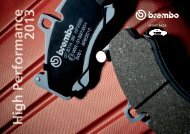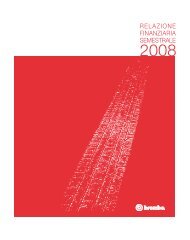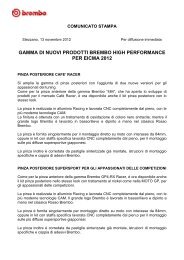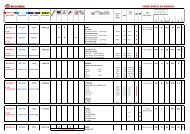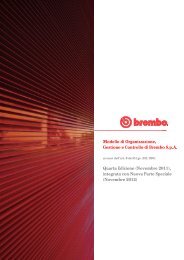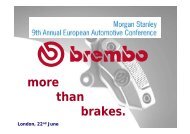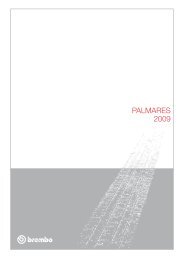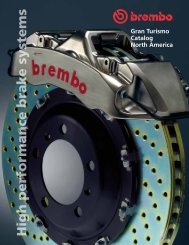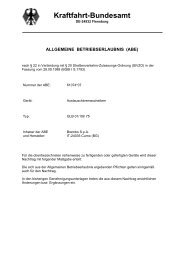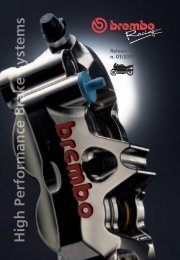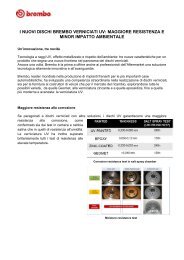Create successful ePaper yourself
Turn your PDF publications into a flip-book with our unique Google optimized e-Paper software.
g. Verify that there are no leakages from the various fittings and<br />
connections. If the braking system has been bled properly,<br />
following the lever dead travel, you will feel the direct action of<br />
the fluid without any sponginess; if this is not so, repeat the<br />
bleeding procedure.<br />
N.B.:<br />
Brake fluid corrodes paints<br />
• Bleeding will not eliminate completely the air that is<br />
present in the braking system; the small residual air<br />
bubbles that remain in the braking system will be<br />
eliminated auto matically during the initial brake<br />
applications: this will result in a shorter lever travel and<br />
less elastic feeling.<br />
10.2. Notes<br />
If the lever seems too elastic following the bleeding procedure,<br />
proceed in the following manner:<br />
a. Remove one brake pad from a caliper.<br />
b. Apply the brakes several times so as to push-out the pistons<br />
about 3/4 mm.<br />
c. Push back the pistons (avoid damaging the disc and the<br />
pistons).<br />
d. Put the brake pad back into the caliper.<br />
e. Repeat the above steps on the other(s) pad(s) and/or caliper(s).<br />
f. Verify whether brake lever travel has improved.<br />
11. RUNNING-IN<br />
(BURNISH PROCEDURE)<br />
a. Except for particular instructions for specific friction materials,<br />
running-in may be done after 5 laps at average speed; at least<br />
90% of the pad surface must be in contact with the disc surface<br />
for running-in to be considered complete.<br />
b. Avoid running under power with the brakes applied; this will<br />
cause sudden temperature increases which may change the<br />
friction characteristics of the pads.<br />
c. It is suggested to use used pads for new discs and used<br />
discs for new pads.<br />
12. BRAKING SYSTEM FINAL<br />
INSPECTIONS<br />
After running a few laps, it is necessary to carry out the following<br />
checks:<br />
a. The wheels must rotate freely without any residual torque.<br />
b. There must not be any interference between disc and caliper.<br />
c. The caliper temperature must not exceed 130 °C (verify through<br />
the thermotapes of the caliper see fig. 3).<br />
13. BRAKE EXAMINATION FOLLOWING<br />
USE<br />
13.1. Fittings<br />
Verify that there are no leakages from the various components,<br />
connections, or fittings. If a leak is found on one of the fittings,<br />
either increase the tightening torque, or replace the defective<br />
component.<br />
13.2. Steel discs<br />
a. The discs must be free from cracks of any kind (either<br />
originating from the holes or from the borders) and must not<br />
show anomalous wear or scratch marks.<br />
b. Thickness of the braking surfaces cannot be reduced by more<br />
than 0.4 mm with respect to the original thickness (0.2 + 0.2<br />
mm for each of the two braking surfaces). Defective or<br />
excessively worn discs should be changed; keep in mind that<br />
when a disc has to be changed, the whole disc-bell assembly<br />
must be changed.<br />
g. Verificare che non ci siano perdite nel circuito. Se l’operazione<br />
di spurgo è stata effettuata correttamente, non si avvertirà alla<br />
leva “l’effetto spugna”, indicante la presenza d’aria<br />
nell’impianto. In quest’ultimo caso è obbligatorio ripetere le<br />
operazioni di spurgo.<br />
N.B.: Il fluido freni è corrosivo<br />
• Lo spurgo non elimina TUTTA l’aria all’interno del circuito,<br />
qualche piccolissima bolla d’aria resterà necessariamente<br />
all’interno. Queste bollicine saranno eliminate<br />
automaticamente durante la fase di primo utilizzo dei freni,<br />
come risultato si noterà un accorciamento della corsa leva.<br />
10.2. Note<br />
Qualora non si riesca ad eliminare l’effetto spugna nonostante<br />
ripetute procedure di spurgo, effettuare la seguente operazione:<br />
a. Rimuovere una pastiglia freno dalla pinza.<br />
b. Azionare la leva freno in modo da far uscire di 3/4 mm il<br />
pistoncino dalla propria sede.<br />
c. Spingere il pistoncino completamente in sede.<br />
d. Rimontare la pastiglia.<br />
e. Ripetere l’operazione descritta applicandola a tutti i pistoncini.<br />
f. Verificare l’effetto di quest’operazione.<br />
11. DISCHI IN ACCIAIO<br />
a. Fatta eccezione per alcuni specifici materiali d’attrito, il<br />
rodaggio dovrebbe essere terminato dopo circa 5 giri di pista<br />
compiuti a velocità media, quando cioè almeno il 90% della<br />
superficie del materiale d’attrito è venuto a contatto con il<br />
disco.<br />
b. Evitate di rodare le pastiglie mantenendo sia l’acceleratore che<br />
il freno azionati: così facendo si generano sovratemperature che<br />
possono portare a variazioni sostanziali delle caratteristiche del<br />
materiale d’attrito.<br />
c.<br />
Rodare i dischi nuovi utilizzando pastiglie usate.<br />
Rodare le pastiglie nuove utilizzando dischi usati.<br />
12. CONTROLLO FINALE<br />
Dopo aver percorso alcuni giri di pista, è conveniente<br />
effettuare i seguenti controlli.<br />
a. La ruota deve poter ruotare liberamente (la coppia residua deve<br />
essere quindi minima).<br />
b. Non ci deve essere alcun’interferenza tra disco e pinza freno.<br />
c. La temperatura della pinza in esercizio non deve superare i<br />
130° centigradi (fate riferimento alle thermo tapes descritte in<br />
figura 3).<br />
13. ISPEZIONE COMPONENTI DOPO<br />
L’USO<br />
13.1. Raccordi tubazioni<br />
Verificare che non ci siano perdite dai vari componenti; se ci fosse<br />
un trafilaggio dalle guarnizioni dei raccordi provare ad aumentare<br />
leggermente il serraggio del bocchettone. Se la perdita persistesse,<br />
sostituire il componente.<br />
13.2. <strong>Disc</strong>hi in acciaio<br />
a. Il disco deve essere assolutamente privo di cricche (siano esse<br />
generate dai fori di pulizia pastiglie oppure dal bordo del disco)<br />
e non devono presentare alcun consumo anomalo.<br />
b. Lo spessore minimo dei dischi in acciaio è di 0,5 mm. inferiore<br />
allo spessore di partenza.<br />
La sostituzione del disco freno comporta necessariamente<br />
anche la sostituzione di tutto l’assieme disco/campana.<br />
7



